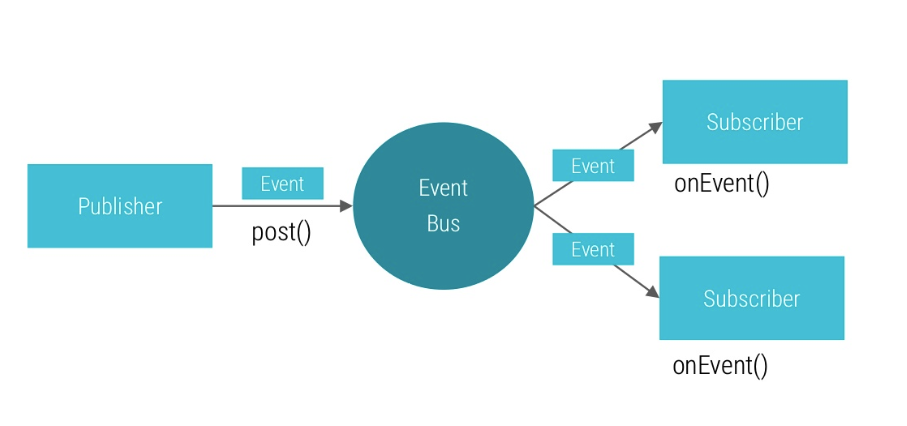EventBus專案中觀察者模式解析
阿新 • • 發佈:2018-11-07
概括:
觀察者模式是Android一個非常常用的設計模式,它完美的將觀察者和被觀察的物件分離開,定義了物件間的一種一對多的依賴關係,以便一個物件的狀態發生變化時,所有依賴於它的物件都得到通知並自動重新整理。
EventBus介紹:
EventBus是Android下高效的釋出/訂閱事件匯流排機制。是基於JVM內部的資料傳輸系統,其核心物件為Event和EventHandler。作用是可以代替傳統的Intent,Handler,Broadcast或介面函式在Fragment,Activity,Service,執行緒之間傳遞訊息,優點是開銷小,程式碼更優雅,以及將傳送者和接收者解耦。 Event是個著名開源專案,它的原始碼github地址為:
EvenBus 3步驟使用流程
1.定義事件
public static class MessageEvent { /* Additional fields if needed */ }
2.準備訂閱的過程
宣告和註釋自己的訂閱方法,可選指定的執行緒模式
@Subscribe(threadMode = ThreadMode.MAIN) public void onMessageEvent(MessageEvent event) {/* Do something */};
註冊或者取消訂閱者,
@Override
public void onStart() {
super.onStart();
EventBus.getDefault().register(this); } @Override public void onStop() { super.onStop(); EventBus.getDefault().unregister(this); }
3.把發生的時間給傳遞到訂閱者
EventBus.getDefault().post(new MessageEvent());
對EventBus原始碼中的觀察者模式進行解析:
1事件訂閱
publicvoid register(Object subscriber) { Class<?> subscriberClass = subscriber.getClass(); List<SubscriberMethod> subscriberMethods = subscriberMethodFinder.findSubscriberMethods(subscriberClass); synchronized (this) { for (SubscriberMethod subscriberMethod : subscriberMethods) { subscribe(subscriber, subscriberMethod); } } }
2使用反射獲取訂閱資訊:
private List<SubscriberMethod> findUsingInfo(Class<?> subscriberClass) { FindState findState = prepareFindState(); findState.initForSubscriber(subscriberClass); while (findState.clazz != null) { findState.subscriberInfo = getSubscriberInfo(findState); if (findState.subscriberInfo != null) { SubscriberMethod[] array = findState.subscriberInfo.getSubscriberMethods(); for (SubscriberMethod subscriberMethod : array) { if (findState.checkAdd(subscriberMethod.method, subscriberMethod.eventType)) { findState.subscriberMethods.add(subscriberMethod); } } } else { findUsingReflectionInSingleClass(findState); } findState.moveToSuperclass(); } return getMethodsAndRelease(findState); }
3使用EventBusAnnotationProcessor解析結果獲取訂閱資訊
private List<SubscriberMethod> findUsingInfo(Class<?> subscriberClass) { FindState findState = prepareFindState(); findState.initForSubscriber(subscriberClass); while (findState.clazz != null) { findState.subscriberInfo = getSubscriberInfo(findState); if (findState.subscriberInfo != null) { SubscriberMethod[] array = findState.subscriberInfo.getSubscriberMethods(); for (SubscriberMethod subscriberMethod : array) { if (findState.checkAdd(subscriberMethod.method, subscriberMethod.eventType)) { findState.subscriberMethods.add(subscriberMethod); } } } else { findUsingReflectionInSingleClass(findState); } findState.moveToSuperclass(); } return getMethodsAndRelease(findState); }
4繫結訂閱物件和方法
private void subscribe(Object subscriber, SubscriberMethod subscriberMethod) { Class<?> eventType = subscriberMethod.eventType; Subscription newSubscription = new Subscription(subscriber, subscriberMethod); CopyOnWriteArrayList<Subscription> subscriptions = subscriptionsByEventType.get(eventType); if (subscriptions == null) { subscriptions = new CopyOnWriteArrayList<>(); subscriptionsByEventType.put(eventType, subscriptions); } else { if (subscriptions.contains(newSubscription)) { throw new EventBusException("Subscriber " + subscriber.getClass() + " already registered to event " + eventType); } } int size = subscriptions.size(); for (int i = 0; i <= size; i++) { if (i == size || subscriberMethod.priority > subscriptions.get(i).subscriberMethod.priority) { subscriptions.add(i, newSubscription); break; } } List<Class<?>> subscribedEvents = typesBySubscriber.get(subscriber); if (subscribedEvents == null) { subscribedEvents = new ArrayList<>(); typesBySubscriber.put(subscriber, subscribedEvents); } subscribedEvents.add(eventType); if (subscriberMethod.sticky) { if (eventInheritance) { // Existing sticky events of all subclasses of eventType have to be considered. // Note: Iterating over all events may be inefficient with lots of sticky events, // thus data structure should be changed to allow a more efficient lookup // (e.g. an additional map storing sub classes of super classes: Class -> List<Class>). Set<Map.Entry<Class<?>, Object>> entries = stickyEvents.entrySet(); for (Map.Entry<Class<?>, Object> entry : entries) { Class<?> candidateEventType = entry.getKey(); if (eventType.isAssignableFrom(candidateEventType)) { Object stickyEvent = entry.getValue(); checkPostStickyEventToSubscription(newSubscription, stickyEvent); } } } else { Object stickyEvent = stickyEvents.get(eventType); checkPostStickyEventToSubscription(newSubscription, stickyEvent); } } }
5解除訂閱
/** Unregisters the given subscriber from all event classes. */ public synchronized void unregister(Object subscriber) { List<Class<?>> subscribedTypes = typesBySubscriber.get(subscriber); if (subscribedTypes != null) { for (Class<?> eventType : subscribedTypes) { unsubscribeByEventType(subscriber, eventType); } typesBySubscriber.remove(subscriber); } else { logger.log(Level.WARNING, "Subscriber to unregister was not registered before: " + subscriber.getClass()); } }
6事件釋出相關
public void post(Object event) { PostingThreadState postingState = currentPostingThreadState.get(); List<Object> eventQueue = postingState.eventQueue; eventQueue.add(event); if (!postingState.isPosting) { postingState.isMainThread = isMainThread(); postingState.isPosting = true; if (postingState.canceled) { throw new EventBusException("Internal error. Abort state was not reset"); } try { while (!eventQueue.isEmpty()) { postSingleEvent(eventQueue.remove(0), postingState); } } finally { postingState.isPosting = false; postingState.isMainThread = false; } } }
//釋出sticky event
public void postSticky(Object event) { synchronized (stickyEvents) { stickyEvents.put(event.getClass(), event); } // Should be posted after it is putted, in case the subscriber wants to remove immediately post(event); }
觀察者模式作用:
它的最大作用是解耦,修改一個地方的一句程式碼,往往會牽涉到其他地方也需要跟著一起做修改。這就是一種耦合。牽一髮而動全身,這樣會給程式埋下很大的安全隱患,特別是在功能強大起來,程式碼量增加以後。而觀察者模式可以很大程式的解決這樣的耦合問題,讓程式碼簡約、耦合度低。
在專案中作用:
最大作用是解耦事件訂閱和釋出者,將事件的訂閱和釋出很好地解耦,使程式碼更優雅,邏輯更清晰。
避免了複雜且易導致錯誤的依賴和生命週期問題,該專案已經在100,000,000+個應用上得到了證明
